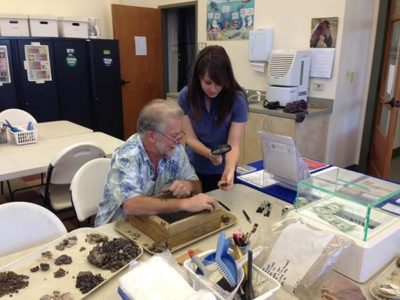Connecting with the connectionless, or: How I stopped worrying and came to terms with the Snowbirds
I happen to be a public archaeologist in a place many might envy (especially after…
 The Past
The Pastby Beverly Chiarulli
Since 2007, I have been interested in using virtual reality to recreate archaeological experiences. That year, Scott Moore, of the Indiana University of Pennsylvania (IUP) History Department and I received funding from the University to develop “Archaeology Island” in Second Life. The Island contained four virtual archaeological experiences based on Scott’s investigations in Roman sites in Cyprus and underwater sites and my investigations of Maya sites, like Cerros in Belize and Late Prehistoric sites in Pennsylvania. The site developed on Second Life in a haphazard way until 2009 when one of my students, Marion Smeltzer, became interested in the site, revamped it, and even began to develop additions.
Marion added new components including the Laurel Hill/Brown farm. The farm, established in 1790 and occupied until the 1960s, was the site of an antebellum community of former slaves located on top of a ridge in the Allegheny Mountains in western Pennsylvania. Because of its inaccessibility, the area has been reconstructed virtually to show the landscape, buildings and stone marking the graves of Civil War Colored Troops. Marion worked with the local community to reconstruct the site in Second Life.
Four years after its start, IUP’s Archaeology Island moved from Linden Lab’s Second Life to the OpenSim VIBE grid, an alternative virtual environment that can be used as a tool for visualization, training, and scientific discovery. Most of the Archaeology Island redesign and move to Vibe has been undertaken by Marion Smeltzer now a Graduate Student in the Anthropology Department MA in Applied Archaeology Program. A short video about Archaeology Island is on YouTube.
by Marion Smeltzer
A virtual world is an Internet based, simulated environment where motion enabled avatars, graphic images and 3D models represent people, places, and objects. As online learning becomes an important part of instruction in high schools and university settings, our challenge is to develop curricula that incorporates archaeology into these courses. Our goal as educators and developers is to create virtual learning environments that can be customized to accommodate each teacher’s specific needs.
Digitization of real objects into 3D models is a growing field and includes a range of applications used in the entertainment industry, design, architecture, scientific research, and virtual class rooms. One of the most interesting areas of its application is in the creation of realistic 3D scenes such as virtual reality; however, the creation of reliable and realistic virtual historic landscapes is problematic due to inaccuracies in historic sources, the lack of computerization tools, and poor-defined visualization requirements (Boer 2010). Nonetheless, archaeologists have written on this blog and elsewhere about the use of 3D modeling and scanning for the use of public engagement.
My MA Thesis at IUP will be to apply 3D modeling tools to historic structures in order to demonstrate the technology’s applications for non-invasive site resource recording. The structures being modeled are located at the Allegheny Portage Railroad in Cambria County, Pennsylvania. This railroad became known as the finishing piece of the Pennsylvania Mainline Canal, marking the first time that there was a direct route between Philadelphia and Pittsburgh. Hailed as a great achievement in early transportation, its use ended during the 1840s and 1850s as America’s rail network developed.
Today, the Allegheny Portage Railroad National Historical Site preserves this early railroading experiment that used ten inclines to pull the canal boats over the Allegany Mountains along the 36-mile long corridor that is on the Allegheny Portage Railroads’ historic route. This research will investigate the historic structures located at the highest point of the Portage which includes the historic Lemon House (an historic tavern), Engine House #6, and the Skew Arch Bridge. The goal of this research is to scan the structures and inline at incline and level 6 to provide detailed maps for the NPS. This data will then be used as the basis for creating 3D virtual landscapes of these structures. This project will be one step in developing digital 3D modeling as a new form of historic property documentation and will illustrate how this technology will assist future archaeologists. The information will also provide the NPS with an additional resource of baseline information to more effectively monitor the environmental factors that could affect these significant resources through time.
The Leica Scan Station C10 will be used to create a highly accurate sub centimeter 3D scan of the structures and features at the Alleghany Portage level and incline 6, and create 3D models of the historic structures in a virtual environment. The Leica Scan Station C10 is a pulsed digital laser scanner which can rapidly produce millions of survey points to produce 3D images. The 3D models created from the scans will show a more detailed view of the structures and their placement on the landscape. In addition to aiding the NPS in monitoring their historic resources, this research will provide a case study of the advantages that 3D scanning provides to the preservation community and general public as a rapid non invasive method of recording important historic resources.
Virtual environments engage students by immersing them in the experience. They can provide students with the opportunity to role play in some of the same ways that historical re-enactments provide students with alternative learning experiences. The goal is use the natural curiosity that students have to immerse them in a science or history based lesson. Vibe (Virtual Islands for Better Education), (VIBE) is an OpenSim platform developed by the collaboration of schools and educators to create learning tools within a virtual environment. More details on the virtual worlds developed for educational programs can be found in a recent article, “Three Virtual Environment Platforms that Inspire Learning” by Ann Cudworth, in the November 24, 2013, issue of Hypergrid Business, the Magazine for Enterprise users of Virtual Worlds.
Toogood, Anna Cox
1973 Historic Resource Study: Alleghany Portage Railroad National Historic Site Pennsylvania
Zitzler, Paula A.
2001 Between a Rock and a Hard Place: The Archaeology of the Allegheny Portage Railroad. Manuscript on File, Archaeological Services, Indiana University of Pennsylvania, Indiana, Pennsylvania.
